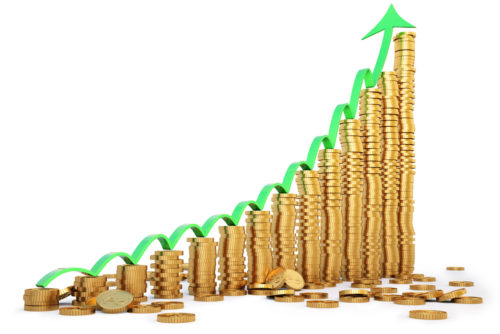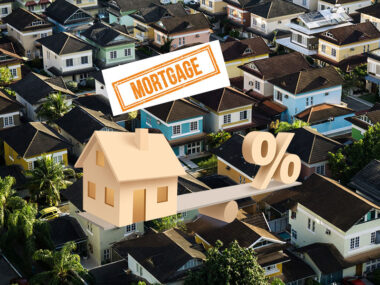Inflation, deflation, hyperinflation, and stagflation are related terms that are used as quantitative measures within the field of economics.
Each term is associated with a set of particular causes and, in theory, a specific set of effects. Each term takes into account purchasing power, employment, and the price of goods and services as they relate to economic growth or decline over various periods of time.
To put it another way, inflation, deflation, stagflation, and hyperinflation measure how much power your money has to buy things and how much those things cost when compared to the past.
Table of Contents
Inflation Definition
Inflation is a quantitative measure that is most often shown as a percentage. It indicates that the average prices of goods and services have increased over time. It also suggests that the purchasing power of a nation’s currency has decreased, meaning the currency itself is worth less than it was in the past.
This is typically due to the fact that the currency is being created at a faster pace than the economy is growing. In other words, more money is being pumped into the economy than there are goods to purchase with it.
While there are multiple ways to measure inflation, the most common index referenced is the Consumer Price Index (CPI). This considers the weighted average of the retail price of important goods and services, such as food and transportation, and plays a role in calculating the minimum wage in some states.
Causes of Inflation
There are a few different causes of inflation:
Demand-pull effect:
In this case, the demand for a product is the key factor. If something is in short supply — say, out-of-season produce, gasoline, or the latest smartphone — it can cause retailers to raise prices in reaction to the shortage.
In addition, if excess money is printed, it can lead to greater consumer spending, which can once again lead to a shortage of supply.
In either case, demand can lead to higher prices, which consequently affects the rate of inflation.
Cost-push effect:
In contrast to the demand-pull effect, the cost-push effect has to do with the creation of products and services.
If, for instance, the cost of labor for an item or service suddenly spikes due to a rise in the minimum wage or scarcity in the raw materials required for manufacturing, this can lead to an increase in the price of the product or service being created.
When this happens, the raised price is an essential factor that directly leads to inflation.
Built-in inflation:
This refers to the natural tendencies within an economy that tend to spur on inflation.
At times this is cyclical. For instance, a rise in wages may be required to meet the rising cost of living. However, the wage increase can lead to higher prices for the products and services being created, which adds to the rate of inflation. The higher prices can necessitate a further increase in pay to match the higher cost of living, and so on.
At other times, an irregular influx of wealth into an economy can be a factor. During the 1849 California Gold Rush, for example, the massive influx of gold into the local economy caused the price of a mining pan to rise from 20 cents to $8.
In either case, the inflation comes from the effect of internal factors within an economy.
Effects of Inflation
Inflation is often viewed as a net negative, and in many ways this is true. It leads to higher prices and devalues cash. Savings can also become less valuable, especially if your money is earning little to no interest.
Nevertheless, inflation can also be a positive thing at times. Those who own assets often benefit from inflation. A house, for instance, may become more valuable than when the owner purchased it.
Inflation can also encourage spending as people look to use their money before it decreases in value. This, in turn, can promote economic growth.
Deflation Definition
In marked contrast to inflation, deflation is a quantitative measure indicating that the average price of goods within an economy has decreased over time. This is typically associated with the fact that there is less money within an economic system when compared to the number of products and services available.
Causes of Deflation
If the overall amount of money within an economic system decreases without the supply of goods and services lowering at a corresponding rate, it can lead to deflation.
In other words, if there is less money to go around, but still the same amount of things to buy, prices tend to drop.
While this can happen for various reasons, there are a few common culprits.
- Deflation is often due to the fact that a period of inflation has occurred and must be counterbalanced by a reduction of the overall currency available.
- Deflation can occur due to the fact that the demand for products and services has decreased, leading to a surplus and lower prices.
- If the productivity of an economy outstrips the rate of the currency being printed, it can also lead to deflation.
Effects of Deflation
Like inflation, deflation has often been seen as a negative economic factor. In the short term, deflation often looks great for consumers. It can allow you to purchase more goods and services with the same income and can lead to higher productivity and new technological improvements.
Still, deflation can also have a much darker side and can affect investment opportunities and money lending, in particular.
It restricts the availability of credit within an economic system as fewer funds are made available. It can also hurt those who have already borrowed money and are now required to reimburse the lender with cash that is worth more than the amount they initially borrowed.
In addition, deflation can often lead to lower demand, which leads to lower productivity, which leads to layoffs and unemployment. This causes people to use their savings, which can ultimately affect the stability of banks, which then struggle to provide loans, causing a destructive cycle to take place.
Stagflation Definition
Stagflation is a combination of the terms stagnation and inflation. It occurs when an unnatural effect, such as a government policy, intervenes with the natural economic flow of inflation and deflation.
Stagflation is marked by an artificial scenario in which the economy is not growing and unemployment is high (signs of deflation) at the same time that an economy is dealing with higher prices (a sign of inflation).
Causes of Stagflation
The specific causes of stagflation are a bit more difficult to pin down than more traditional terms like inflation and deflation.
In general, stagflation tends to occur when a government enforces conflicting policies. For instance, if a government prints more money and increases taxes at the same time, it’s adding to inflation via the former and discouraging productivity with the latter.
The 1970s was an infamous period in U.S. history that was rampant with stagflation. During this time, the government set about printing more money while simultaneously instituting restrictive policies, such as wage-price controls that lowered the overall supply of labor.
Effects of Stagflation
Stagflation typically tends to be bad news no matter how you look at it. The two main factors to consider here are increased prices and higher unemployment.
When it comes to inflation, as prices rise, income levels rise in order to match the new cost of living. On the other hand, when deflation occurs it is often accompanied by increased opportunities for productivity.
When stagflation sets in, though, prices and unemployment both rise together, leading to a crippling effect on the average consumer.
With stagflation, increased prices are often partnered up with less productivity, ultimately leading to unemployment. This can be acutely distressing for the average consumer as they find the cost of living increases while their source of income either remains the same or decreases.
Hyperinflation Definition
While inflation is normal, when prices accelerate past a certain point it becomes hyperinflation.
Hyperinflation can refer to a general spike in prices, although it is most often specifically associated with cases where the monthly inflation rate has surpassed 50%.
Causes of Hyperinflation
Hyperinflation is principally tied to a government dramatically increasing the amount of money being printed within an economy over a short period of time. This exacerbates many of the typical inflation effects.
For instance, if too much money is being pumped into an economy, it may accelerate the demand-pull effect by causing consumers to purchase items rapidly in the anticipation that the prices will continue to rise in the near future.
Another potential cause is a labor strike, which can drastically increase the cost of labor. Bottle-necking the manufacturing process by putting a premium on the cost of labor can quickly lead to higher prices for the increasingly scarce number of products or services created, thus aggravating the cost-push effect.
Effects of Hyperinflation
Hyperinflation often leads to the abandonment of the affected currency both globally and locally.
Foreign markets will look for alternative currencies that are more stable, while those living in the affected nation will often turn to durable goods like jewelry, which will hold their value and aren’t directly tied to the tanking currency.
In day-to-day life, this can manifest by putting a particularly pronounced strain on the consumer’s ability to purchase anything that was easily attainable in the past.
At times this strain can become absurd, as was the case in Germany in 1922 and 1923 when the German mark was valued at 4.2 trillion to one against the American dollar.
When the currency becomes so hyperinflated that it is literally worthless, people often turn to old-fashioned barter systems, assigning natural values to food, services, and other staples that can no longer be purchased with the hyperinflated currency.
Image Source: https://depositphotos.com/





